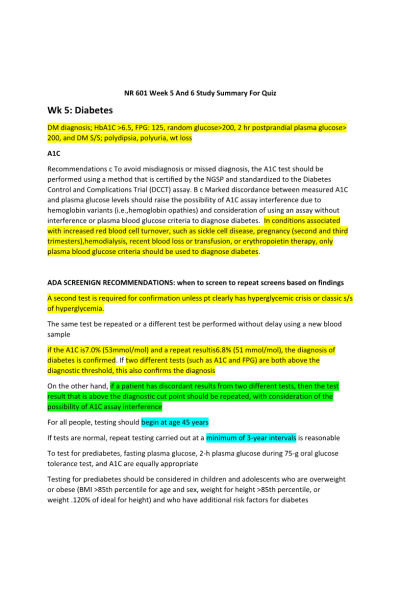NR 601 Week 5 and Week 6 Study Summary for Quiz: October 2020
-
$25.00
| Institution | NR 601 Primary Care of the Maturing and Aged Family |
| Contributor | Claudel |
First Page View
Week 5: Diabetes
DM diagnosis; HbA1C >6.5, FPG: 125, random glucose>200, 2 hr postprandial plasma glucose> 200, and DM S/S; polydipsia, polyuria, wt loss
A1C: Recommendations c To avoid misdiagnosis or missed diagnosis, the A1C test should be performed using a method that is certified by the NGSP and standardized to the Diabetes Control and Complications Trial (DCCT) assay. B c Marked discordance between measured A1C and plasma glucose levels should raise the possibility of A1C assay interference due to hemoglobin variants (i.e.,hemoglobin opathies) and consideration of using an assay without interference or plasma blood glucose criteria to diagnose diabetes. In conditions associated with increased red blood cell turnover, such as sickle cell disease, pregnancy (second and third trimesters),hemodialysis, recent blood loss or transfusion, or erythropoietin therapy, only plasma blood glucose criteria should be used to diagnose diabetes.
ADA SCREENIGN RECOMMENDATIONS: when to screen to repeat screens based on findings
A second test is required for confirmation unless pt clearly has hyperglycemic crisis or classic s/s of hyperglycemia.
The same test be repeated or a different test be performed without delay using a new blood sample
if the A1C is7.0% (53mmol/mol) and a repeat resultis6.8% (51 mmol/mol), the diagnosis of diabetes is confirmed. If two different tests (such as A1C and FPG) are both above the diagnostic threshold, this also confirms the diagnosis
On the other hand, if a patient has discordant results from two different tests, then the test result that is above the diagnostic cut point should be repeated, with consideration of the possibility of A1C assay interference
For all people, testing should begin at age 45 years
If tests are normal, repeat testing carried out at a minimum of 3-year intervals is reasonable
To test for prediabetes, fasting plasma glucose, 2-h plasma glucose during 75-g oral glucose tolerance test, and A1C are equally appropriate
Testing for prediabetes should be considered in children and adolescents who are overweight or obese (BMI >85th percentile for age and sex, weight for height >85th percentile, or weight .120% of ideal for height) and who have additional risk factors for diabetes
Last Page View
What does the AUA state about drawing PSA levels? PSA tests can generate false positives. The cut point for PSA is 4.9 ng/mL,
1. Recommends against PSA screening in men under 40-years-old. Individualized decision should be made for those who are > 55 years at higher risk, such as African American men, strong family history of metastatic or lethal adenocarcinomas who develop symptoms in early ages.
2. Recommends against screening men ages 40 to 54-years-old at average risk.
3. Men age 55 to 69 years old benefit the most from screening. The recommendations states that testing should be done in this group with shared decision making and should be based on the man’s values and preferences.
4. Routine screening interval of two years or more is preferred in men who have chosen to be screened.
5. Does not recommend routine PSA screening in men older than 70-years-old or in a man with less than 10-15 years life expectancy (Carter et al., 2018).
| Instituition / Term | |
| Term | October 2020 |
| Institution | NR 601 Primary Care of the Maturing and Aged Family |
| Contributor | Claudel |







































































